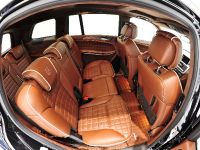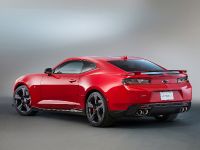24 July 2008
Since 2001, TECHART GTstreet vehicles have been among the fastest and highest performance sports cars in the world. This high performance is reflected in the GTstreet RS’s statistics - 700 PS and 515 KW – with a maximum torque of 860 Nm. This power is achieved through the use of modified turbochargers, enlarged carbon inlet pipes, specially developed intercoolers, a sports flap exhaust combined with high-performance headers, modified pressure sensor and a sports air filter. The GTstreet mode
11 July 2008
This morning, July 11, the Porsche Cars GB-entered Cayenne S Transsyberia driven by professional rally driver, Martin Rowe, and fellow rally driver and automotive engineer, Richard Tuthill, drove out of Moscow, the capital city of Russia, to begin the 2008 Rallye Transsyberia.
As the two Oxfordshire-based men start
11 July 2008
Graduate engineer Jan Fatthauer, creator and also test pilot of the 9ff proprietary development GT9, accelerates and speeds up from the full banked corner on the Papenburg oval course. Accompanied by a sound spectacle of automobile top class, the 964 Newton metres torque push down on the asphalt and vehemently thrust the car forward. At the end of the four kilometre long straight, the display of the satellite-supported time measurement shows an incredible 409 km/h. With such a result, the 9ff GT
10 July 2008
Porsche will be one step closer to acquiring majority control of Volkswagen on September 2, when its deal to buy 4.9 percent of that company's ordinary shares takes effect.
The VW takeover "will be executed piece by piece," Porsche CEO Wendelin Wiedeking said during an event in the Black Forest on Wednesday evening.
A spokesman for Porsche said the deal closes on that day in early September.
The purchase of another 4.9 percent of VW common shares was necessary before Porsche could proceed with gaining regu
03 July 2008
For the company’s 50th anniversary in 1998, Porsche received the most gratifying of all jubilee presents in the form of victory in the Le Mans 24 Hours race, achieved by Laurent Aiello/Allan McNish/Stephane Ortelli.
Using a carbon-fibre chassis for the first time to provide weight and strength advantages, the 911 GT1/98 was an evolution of the GT1 concept that was started in 1996. The GT1 race car had a silhouette that was reminiscent of the road-going 911. However, in many other respects t
03 July 2008
With two wins at the Le Mans 24 Hours race already under its belt, you could be forgiven for expecting a race car to enjoy a well-earned retirement. However, the enduring design and speed of the 936 concept enabled the Porsche racing department at Weissach to further evolve the car such that it won the race once more in 1981.
With plans in place to enter race versions of the 924 Carrera GT and new 944 in the 1981 Le Mans, a late decision was taken to also challenge for overall honours. But th
03 July 2008
The Porsche 936 was a two-seat prototype developed by the engineers in the Weissach racing department for the 1976 Group 6 World Championship – and it was rewarded with that year’s title and a remarkable trio of Le Mans wins.
Led by Norbert Singer, the team of Porsche engineers used the chassis concept that had been proven by the 917 and clothed it in new, open cockpit ‘Spyder’ bodywork.
The 1976 Le Mans 24 Hours race was to be ultimate test of this new design and it passed with fl
03 July 2008
Rule changes for the World Championship of Makes eliminated the stunning Porsche 917 during the early 1970s allowing the factory to develop the car for the open-top Canadian-American (CanAm) Championship in North America. Teams from McLaren, Lola and Chaparral were attracted to the 200 mile Sprint races of the formula and the rule book permitted almost anything, including free engine displacement and the use of turbochargers. Porsche used its new-found skills with forced induction to attach two
03 July 2008
A total of 59 examples of the Porsche 917 were built, 41 as short or long-tail coupes with naturally aspirated engines of up to 5.4-litres, and 18 as CanAm or InterSeries Spyder versions with 1,400bhp turbocharged engines. One model is slightly different; the 917/20, of which only a single example was ever built.
A mixture of the long and short-tail coupes, the goal of the designers of the 917/20 was to combine the high speeds of the long-tail version with the easier handling of the short-tai
03 July 2008
The Mulsanne straight at Le Mans, which is about six kilometres in length, has always played an important role for drivers and engineers in the history of the 24 Hours race. This is where high speed has top priority and decisive seconds can be gained. This is also why, as on no other race track in the world, aerodynamics determine how cars for Le Mans are designed.
A long-tail Porsche only just missed its first Le Mans victory in 1969; it crossed the line about 100 metres behind the winner. T
03 July 2008
With the 917, Porsche for the first time entered the league of immensely powerful, large-capacity racing cars. The 580bhp from the twelve-cylinder 4.5-litre engine of the 917 set new standards, to the extent that even decades later, independent experts rate this Porsche as one of the most impressive sports cars of the century.
Changes in the regulations motivated Porsche to build the 917. Prototypes were allowed a maximum engine size of three-litres, and for sports cars five-litres were allow
30 June 2008
Like an Arabian stallion collecting its attention for a jump. Concentrated and full of dynamic body tension. This is how the silhouette of the super sports car called STALLION presents itself. But the latest development of the premium refiner HAMANN MOTORSPORT offers far more than a fascinating new aerodynamics concept














